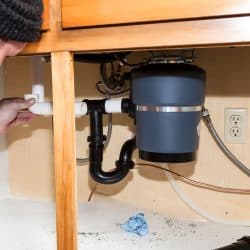Simple Steps to Stop a Leak in Your Garbage Disposal
Simple Steps to Stop a Leak in Your Garbage Disposal
Blog Article
Everyone has got his or her own way of thinking in relation to Why Is .

Garbage disposals are essential cooking area appliances that assist in taking care of food waste successfully. Nonetheless, a leaking waste disposal unit can be a frustrating and messy trouble to manage. Luckily, lots of leakages can be taken care of easily with a few straightforward steps. In this short article, we will certainly discuss just how to fix a leaking garbage disposal efficiently.
Intro
Waste disposal unit are set up under cooking area sinks and are made to shred food waste right into smaller sized pieces, permitting it to go through the pipes system easily. While these devices are usually trustworthy, leaks can happen gradually due to wear and tear, loose links, or damages to the unit.
Common Reasons For Leaks in Trash Disposals
Worn Seals and Gaskets
Seals and gaskets play a vital duty in stopping water from dripping out of the waste disposal unit. With time, these elements can degrade, resulting in leaks around the disposal device.
Loose Connections
The connections in between the garbage disposal and the plumbing system can become loosened in time, causing water to leakage out during procedure.
Fractures or Openings in the Disposal System
Physical damage to the waste disposal unit, such as cracks or openings in the housing, can likewise cause leaks.
Recognizing the Source of the Leak
Before attempting to deal with a leaking garbage disposal, it is vital to identify the source of the leakage. This can typically be done with visual inspection or by conducting straightforward tests.
Visual Examination
Check the garbage disposal unit carefully for any indicators of water leak. Pay attention to locations around seals, gaskets, and connection points.
Testing for Leaks
One method to check for leaks is by running water through the disposal system and checking for any type of visible signs of leakage.
Devices and Materials Needed for Fixing a Dripping Waste Disposal Unit
Before beginning the fixing procedure, gather the essential tools and products, including a screwdriver, adjustable wrench, plumbing technician's putty, replacement seals or gaskets, and epoxy or patching product for repairing splits or openings.
Step-by-Step Guide to Taking Care Of a Leaking Waste Disposal Unit
Shut off the Power
Before trying any repair services, ensure that the power to the waste disposal unit device is turned off to prevent the danger of electrical shock.
Situate the Leakage
Identify the exact area of the leakage and determine the cause.
Tighten Connections
Use a wrench to tighten any loosened connections in between the disposal device and the plumbing system.
Change Seals or Gaskets
If the leak is because of worn seals or gaskets, eliminate the old parts and replace them with brand-new ones.
Patching Splits or Openings
For fractures or holes in the disposal unit, usage epoxy or an ideal patching product to seal the damaged location.
Checking the Garbage Disposal After Repair Service
Once the fixing is complete, examine the garbage disposal by running water through it to make certain that the leak has actually been solved.
Preventive Maintenance Tips to Stay Clear Of Future Leaks
To prevent future leaks, it is essential to do regular upkeep on your garbage disposal. This consists of keeping it tidy, avoiding placing non-food products or difficult items down the disposal, and periodically checking for leaks or various other issues.
Conclusion
In conclusion, dealing with a leaking garbage disposal is a fairly simple process that can be finished with standard devices and materials. By adhering to the steps outlined in this short article and practicing preventive upkeep, you can keep your garbage disposal in good working problem and avoid expensive fixings in the future.
HERE’S HOW TO FIX YOUR GARBAGE DISPOSAL
WHAT TO DO IF SOMETHING IS STUCK IN YOUR GARBAGE DISPOSAL
If the impeller won’t turn, there’s probably something stuck in the disposal. It could be a steak bone or peach pit, although plumbers report pulling all sorts of inappropriate objects out of disposals, such as bottle caps or aluminum foil. Make sure power to the disposal is off, and look inside to see if you can see the source of the jam.
Never stick your fingers in a disposal. Pull out anything you see with tongs or pliers.
If the disposal still won’t work, it may be time to call a plumber or consider buying a new disposal. GEM Plumbing & Heating is here for all of your garbage disposal needs.
WHAT TO DO IF YOUR GARBAGE DISPOSAL DRAIN IS CLOGGED
Take everything out from underneath your sink and put a bucket or other container under your disposal to catch any water that drains out. Disconnect your disposal from the power supply. If it’s plugged into a wall outlet, unplug it. If it’s hardwired into an electrical box, go to the electrical panel and turn off the breaker for the disposal. Pour ¼ cup of baking soda into the drain, followed by ½ cup of white vinegar. Give the solution a few minutes to fizz and do its work. Look into the disposal with a flashlight to see if you can see an object that might be causing the clog. If you see it, remove it using tongs or pliers. MORE TIPS ON DEALING WITH A CLOGGED GARBAGE DISPOSAL
Never use drain cleaner in a garbage disposal. It can damage the plastic parts inside the disposal. You can also be splashed with the caustic liquid while working to clear the clog. Beware! Never stick your fingers into a garbage disposal. Trust us — not a good idea. In many instances, your dishwasher drains through your garbage disposal. This allows the disposal to grind any large food particles that may be drained out of your dishwasher. There are some jurisdictions, however, where the plumbing code prohibits such a connection. WHAT TO DO WHEN YOUR DISHWASHER DRAINS THROUGH THE DISPOSAL
Run some water in the sink so your plunger has at least a ½-inch of water to create a seal and plunge vigorously up and down several times. You may need to repeat this several times. Run hot water down the drain to clear any residue that remains.

I am very serious about Why Is and I hope you appreciated the entire piece. Be sure to take the opportunity to promote this page if you liked it. Kudos for your time. Visit again soon.
See Availability Report this page